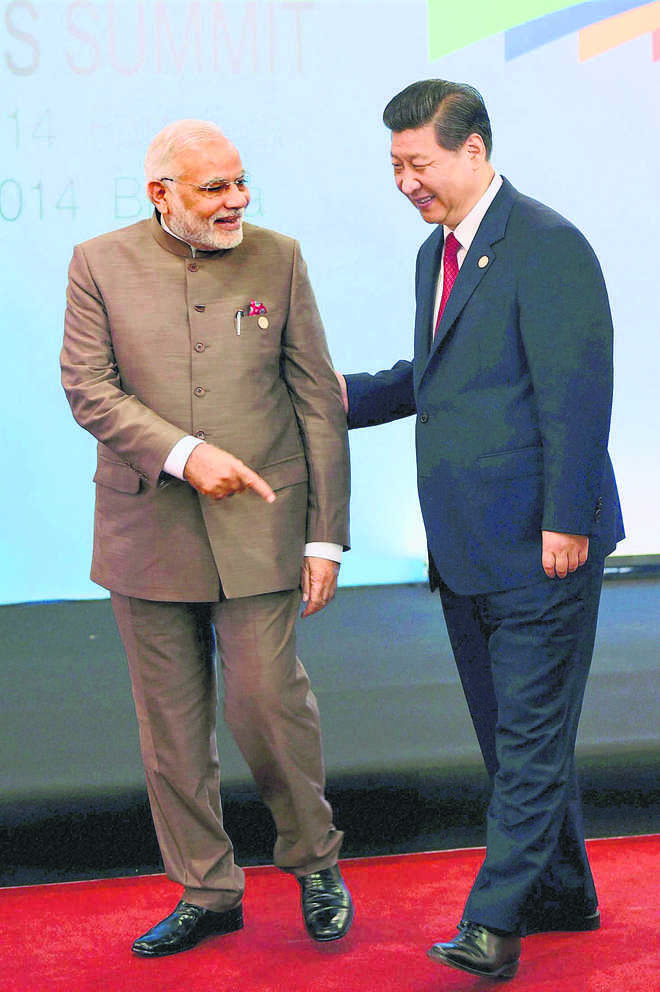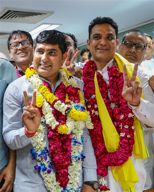
Defrost: The Wuhan meeting could be an inflection point for ties.
KC Singh
The informal summit announced between Chinese President Xi Jinping and Indian Prime Minister Narendra Modi on April 27-28 came as a bit of a surprise though some signals were there since February of an emerging thaw. The relationship had not fully normalised since the Doklam standoff last year, although the claimed withdrawal of Chinese forces had allowed Modi to attend the BRICS Summit. Subsequent reports, not convincingly denied by India, indicated that the Chinese had withdrawn a few hundred yards and then bivouacked in greater numbers, when normally they should have returned to the Tibetan plateau once winter set in.
The Chinese conduct in again vetoing the listing of Pakistani terrorist Masood Azhar by the United Nations Sanctions Committee and persisting to oppose Indian membership of the Nuclear Suppliers Group showed, if anything, the Chinese were post-Doklam more confrontational. Freezing of joint military exercises, an effective confidence-building measure for the maintenance of peace and stability at the LAC also signalled sullenness.
But geopolitical changes began to overtake this downturn in relations between the two Asian powers. The Quad, a grouping of Australia, India, Japan and US, was revived last year after its first and last meeting in 2006, on the sidelines of the Asean Regional Forum (ARF). (I led the Indian delegation as an additional secretary.) The move then was led, as now, by Japanese PM Shinzo Abe with then US President George W Bush, a reluctant participant, as the US still counted on Chinese goodwill to resolve the nuclearising of the Korean peninsula. The message to China was then, and now, clear. Its actions in unilaterally revising maritime regimes by creating artificial islands in the South China Sea and then turning them into military bases, disregarding the sovereignty of half a dozen neighbours, was unacceptable.
The election of President Donald Trump as the US President has also adversely affected China. While he has blown hot and cold on Russia, about China he has stridently argued trade imbalances and intellectual property theft. His outreach to the supreme leader of the Democratic Republic of Korea (DPRK), Kim Jong-un, announcing even readiness for a face-to-face meeting, impinges on the Chinese strategic calculus. Mike Pompeo, head of the Central Intelligence Agency and future Secretary of State, meeting Kim means the US game is moving apace. China would also be concerned about losing an important buffer that keeps Japan and the Republic of Korea (ROK) distracted and tied down.
Trump has also, as promised, fired the first salvo in a potential trade war between the US and China, announcing in March $50 billion in tariffs on select Chinese products. US Treasury has been asked to craft investment restrictions on China, characterising them as defence against “economic aggression”. In 2016, while the US exported goods worth $115.6, its imports from China were $462.4. The $385 billion deficit is actually half US trade deficit globally. US sanctions can affect Chinese industry drastically. For instance, China’s state-owned and second largest telecommunication company ZTE has been sanctioned for illegal re-export of US routers, servers and microprocessors to Iran and DPRK. Estimates are that 80-90 per cent of their products rely on US components.
The Modi government perhaps realises that antagonism with China makes it more difficult to handle neighbours in SAARC. Ranging from Sri Lanka to the Maldives, and now Nepal Sino-Indian differences are used for economic and strategic advantage. India also realises that Trump, despite his bonhomie, will not dilute his core beliefs and promises to his base. India should expect little, or no accommodation, on immigration or trade issues. He could also cut a deal with China, provided he gets trade and market access concessions. His flip-flop on joining Trans Pacific Partnership shows he is “ideology neutral”, but driven by tangible gains, thus capable of jettisoning Asia-Pacific if his self-interest so dictates.
Global Times, often used by China to signal antagonism or warmth, has been gushing of late that “within China hostility toward India is being replaced by hopes for friendly ties”. It claims, “Indian academia and political circles have agreed the country needs cooperative ties with China”. Perhaps allusion is to the BJP or CPM circles in India as others have not yet revised the opinion on China softening its India-containment policies of the past five decades. It then likens the “informal summit” to the 1988 Rajiv Gandhi-Deng Xiaoping meeting. Modi may not like the comparison; the Chinese take history very seriously. Is China preparing for a fundamental shift, allowing India strategic space in South Asia, in exchange for India not ganging up with the US and Japan? Thus, Wuhan meeting could be an inflection point for Sino-Indian relations. It is good no joint statement is planned as both sides need to insulate the process from hyper nationalists at home.
Significantly, the last major Sino-Indian agreement was in 2005, during the visit of Chinese Premier Wen Jiabao. In it were spelled out the “political parameters and guiding principles for the settlement of the boundary dispute”. India was then in the final stages of concluding the nuclear agreement with the US, which was to liberate India from the shackles of dual technology control regimes. China perhaps gamed to draw India away from a closer and strategic engagement with the US. After the Indo-US agreement in 2008 and the global financial crisis the same year, India and Asia have been dealing with a different China.
The current thaw commences from the visit of Foreign Secretary Vijay Gokhale to China in February and his note thereafter to the Cabinet Secretary to downgrade official participation in the 60th anniversary celebration of the arrival of the Dalai Lama in India. Then followed visits by the National Security Adviser, External Affairs Minister and Defence Minister. That has set the stage for the summit. Ideally, Modi should meet opposition leaders before leaving to project national unity that the Chinese appreciate. China sees the political dissonance in India and mounting domestic difficulties for Modi. The temptation to score points over the Opposition must be avoided. It is perhaps the most critical inflection point for Modi’s foreign policy. Modi has an opportunity to show that despite multiple foreign policy stumbles, Modi the statesman has finally emerged and eclipsed Modi the showman.
The writer is a former Secretary, Ministry of External Affairs



























